Having the ability to read and recognize music note symbols is an important part of a musician’s musical education. Being able to quickly recognize a note, rest, or any other music symbol helps the musician to successfully navigate a piece of music and understand exactly what’s happing in a piece of music.
The types of music symbols that a musician may come across in a piece of music are notes, note values, rests, dotted notes, dotted rests, repeat signs, sharps, flats, naturals, and all types of chords. All of these symbols are the roadmap in which musicians must recognize in order to read a piece of music.
Let’s take a look at each of these symbols and start applying them to our music.
Types of Music Note Symbols
Standard Note Values
Note values tell a musician how long to hold out a note in a piece of music. Here are some of the notes you will encounter:
A whole note is an oval shaped note with a hole in the center..
A half note is similar to a whole note in that it is has the same oval shape, but this note has a staff that connects to the note and can goes either up or down.
A quarter note is similar to a half note. Instead of the center of the note being cut out it’s filled in.
An eighth note looks like a quarter note with one flag connected to the stem.
The sixteenth note is similar to an eighth note, but rather than having only one stem, the sixteenth note has two stems.
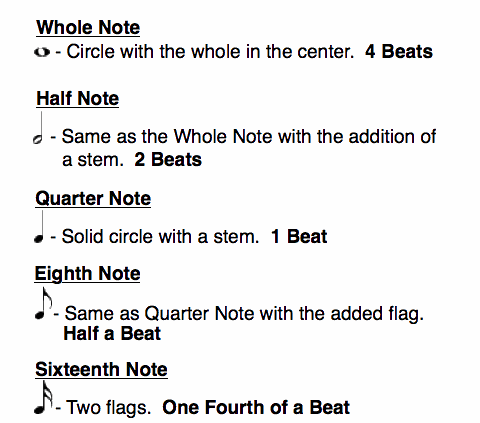
Rests
A rest is similar to the music note symbols that we discussed above, however the difference with a rest is that it represents silence. A standard note shows how long to hold out a tone, but a rest shows how long to hold out silence.
A whole rest is a small rectangular box that that sits on a staff line and points down.
A half rest is identical to the whole rest except this rest points up.
A quarter rests is a music note symbol that looks like a squiggle mark and represents one beat of silence.
An eighth rest is a small dash with one flag pointing to the left.
A sixteenth rest is similar to an eighth rest but the has two flags.
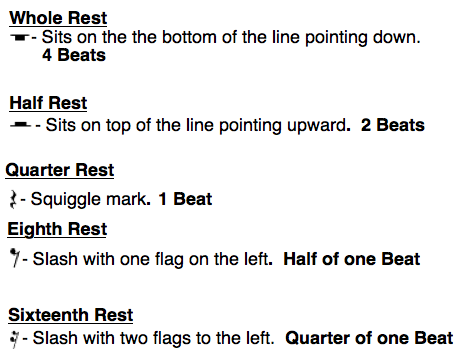
Dotted Notes and Rests
Dotted notes are important when reading music in that it directs the musician on how long to hold out a note or rest. Dots can be added to both standard music note symbols and rests.
The Dot is used to add time to the original note that is being played.
For example, if you were playing a dotted half note you would play the original two beats of the half note, and then add half of the amount of time of the half note. The dotted half note would then last three beats. You play the two beats of the half note, and then add one more beats for half of that note giving you three beats.
This can also be applied to rests. If you have a dotted half rest, you will rest for three beats. Use the two beats of the half rest, and then add half of that two beats which would give you another beat, for a total of three beats of silence.
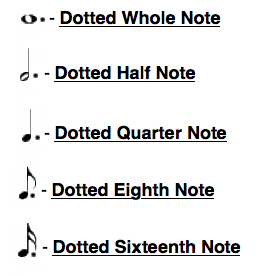
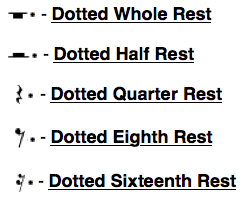
Repeat Signs
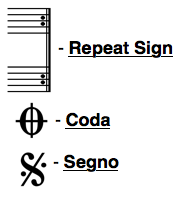
Repeat signs are important in music because they give the musician a roadmap of where they are supposed go in the piece of music.
It guides the musicians when to stop, when to repeat back to the beginning, and general directions on where to go in the piece of music. You wouldn’t drive to an unknown destination without a map, and you wouldn’t play a piece of music without repeat signs and other important directional information.
The three main type of repeat signs are the basic Repeat Sign, the Coda Sign, and the Segno. These three signs are touched on in more detail here.
Sharps, Flats, and Naturals
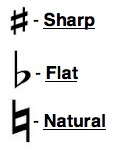
A sharp is a music note symbol that looks like a number sign. It represents changing the tone of the note up on half-step. If a note is sharp, it tells us that we have to move to the note directly to the right.
For example: If you are on a D note, and want to make it sharp, move to the note directly to the right which will be D sharp.
A flat, is the looks like a lowercase b and is the exact opposite of a sharp. Instead of moving to the note to the right, we move to the note directly to the left. So if we want to flat a D note, we will be playing D flat, which is the black note to the left of D.
A Natural tells the musician that rather than playing a sharp or a flat, they are to play the natural note. If the music normally calls for a Db, adding the natural sign means to play a D instead.
Chords

When you see three or more notes stacked one on top of another, you have a chord. Almost all chords are represented by three notes. These three notes also called a triad. This tells you to play these three or more notes simultaneously.
Here is some more great information on chords.
Understanding music notes symbols is vital when reading music. They give the musician direction, guide them on how long to hold out notes, and guides them on how long to add silence. They also give the musician important information on what notes are to be played such as sharps or flats.
Knowing these key elements is essential to learning and understanding how to play piano.
Go From Music Note Symbols Back to Piano Theory
Back to Home Page

